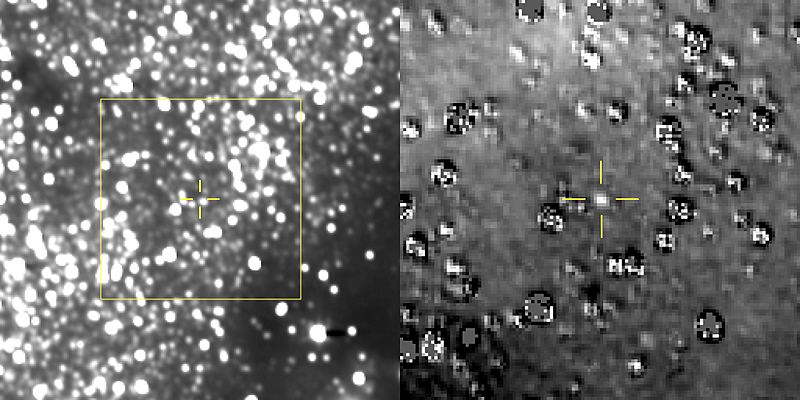Archivo: Nh ultima thule first detection v3

Descripción: The figure on the left is a composite image produced by adding 48 different exposures from the News Horizons Long Range Reconnaissance Imager (LORRI), each with an exposure time of 29.967 seconds, taken on Aug. 16, 2018. The predicted position of the Kuiper Belt object nicknamed Ultima Thule is at the center of the yellow box, and is indicated by the red crosshairs, just above and left of a nearby star that is approximately 17 times brighter than Ultima. At right is a magnified view of the region in the yellow box, after subtraction of a background star field "template" taken by LORRI in September 2017 before it could detect the object itself. Ultima is clearly detected in this star-subtracted image and is very close to where scientists predicted, indicating to the team that New Horizons is being targeted in the right direction. The many artifacts in the star-subtracted image are caused either by small mis-registrations between the new LORRI images and the template, or by intrinsic brightness variations of the stars. At the time of these observations, Ultima Thule was 107 million miles (172 million kilometers) from the New Horizons spacecraft and 4 billion miles (6.5 billion kilometers) from the Sun. (Image credits: NASA/JHUAPL/SwRI)
Título: Nh ultima thule first detection v3
Créditos: https://www.nasa.gov/feature/ultima-in-view-nasa-s-new-horizons-makes-first-detection-of-kuiper-belt-flyby-target
Autor(a): NASA/JHUAPL/SwRI
Términos de Uso: Dominio Público
Licencia: Dominio Público
¿Se exige la atribución?: No
Usos del archivo
La siguiente página enlaza a este archivo:

